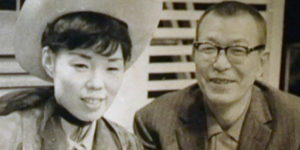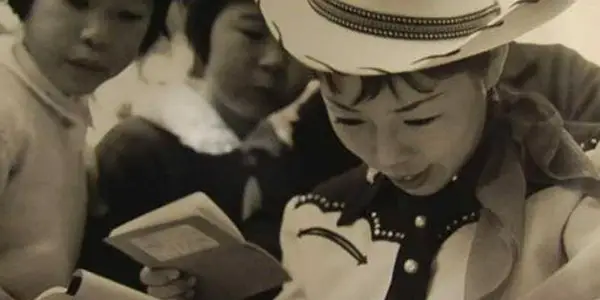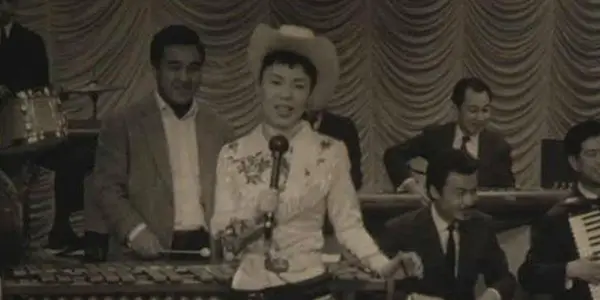MADE IN JAPAN: A Hit in America (Again)?

Frank H. Wu is William L. Prosser Distinguished Professor at…
Made in Japan could have been a minor novelty picture, like its subject, Tomiko Fujiyama, a Japanese country and western singer whose 1964 Grand Ole Opry appearance earned her a standing ovation — among the stars of the scene who strode the stage that night, the only individual to receive such applause. The documentary is much more, depicting the story of a once-famous artist striving to reclaim if only for a moment her past glory. It is as poignant as improbable, following her quest to return to the Nashville venue more than two generations later.
Will a Japanese Cowgirl Be Appreciated?
The movie explains Tomi’s life in post-World War II Japan as well as the significance of country and western tunes around the world as “American music.” She grew up in modest circumstances across the street from a brothel. Her dedication to her calling resulted in her pinkie finger becoming deformed, as she displays. She was supported by her father, who even invented a special amplifier (which he failed to patent).
At the age of twelve, Tomiko — “Tomi” is a nickname coined by Westerners unable to pronounce the extra syllable — was offered her debut recording deal. The promoters, however, turned out to be con men, though the news reports about the scam led to a regular gig, and that, in turn, landed her a real contract.

In short order, she signed with Columbia. She would cut seven albums for the label. She then was invited to Las Vegas, but agreed to terms in English which she did not quite comprehend. The schedule of four shows per night for seven days per week left her hospitalized for exhaustion. After the Grand Ole Opry, she toured regularly with the USO. She was more popular than ever playing for military personnel. She wins fans easily. They are respectful even as she inserts a Japanese number after requesting permission to do so. (There is a brief, cryptic allusion to bias, which Tomi is confident she will not encounter in the Sin City.)
What impresses all observers is her enthusiasm and dedication. They are aware that Tomi has had to work at her passion. There is not a moment when her cowgirl outfit, complete with hat, looks like a put on. It’s all done straight, with no smirk from her or her listeners.
That is possible only because she gives an authentic voice to her material and the suffering of the lyrics. She is still at it, despite a hiatus of several years to care for ailing parents and in-laws. Her repertoire is primarily country and western standards. Playing an assortment of electric guitars, she has a mild accent as she belts out covers such as “Your Cheatin’ Heart.”
Why Did Tomi Love Country & Western Music?
Tomi’s love for the genre should not be all that surprising. Although the documentary does not digress, the subject of East meeting West is hardly esoteric. It is too bad this context is not detailed, but it may be too much for what is intended to entertain. A bit of background: a leading historian of contemporary Japan has described how the nation transformed itself by “embracing defeat.” In peacetime, manufacturers studied the teaching of American quality control gurus who in their own home were cult figures at best and eccentric cranks at worst. Instead of being dismissed as the source of cheap knock-offs, its industrial policies turned it into a place respected for manufacturing premium products.
Japan has long been willing to embrace other cultures. Japanese audiences love jazz and classical music. Japanese consumers will pay top dollar for Harley-Davidson motorcycles and vintage clothing pre-worn by American teenagers. “Yoshoku” is the Japanese version of Western dishes such as beef steak. “Yoga” painting with Western techniques was popularized in the mid-nineteenth century; Chinese literary sources much earlier than that.

Thus ethnic nationalists such as the novelist Mishima protested foreign influence during the same period Tomi exemplified it. The celebrity author and his private militia invaded an Army base so he could deliver a speech arguing for restoration of the Japanese Emperor as a divine authority to lead renewed imperialism. He then committed ritual suicide, eviscerating himself, before one of his compatriots beheaded him. Yet Mishima fascinated those whom he criticized. His book, The Sailor Who Fell From Grace with the Sea, tells of a gang of boys who murder the title character to restore his honor; it was adapted into a 1976 movie of the same name featuring Kris Kristofferson and Sarah Miles, but relocated to England. A biopic, subtitled “a life in four chapters” (1985) referring to excerpts from his fiction, set to an urgent score by minimalist composer Philip Glass, written and directed by Paul Schrader, made the arthouse circuit.
Was Tomi the Only One?
For that matter, Tomi is not the only Japanese singer to hit it big on these shores. Among the misbegotten chapters of television history is the demise of the variety show. Pink Lady is blamed for killing off the once popular format with their eponymous comedy program. They consisted of Mei and Kei. Their schtick in the land of the rising sun was synchronization, as if they formed a single personality. Advertising on the other side of the Pacific Ocean described them as “two oriental lovelies” who “discover America with the zany help of their friend,” adding “it’s the best of both worlds!”
The pop duo had achieved the greatest success ever for a Japanese act, making it onto the Billboard charts with disco style. Their English, however, was memorized phonetically. So producers hired comedian Jeff Altman to serve as host of the program. The half dozen episodes ended with the ladies changing into bikinis behind a shoji screen before forcing tuxedo-clad Altman to join them in a hot tub.
Tomi has fared better than her younger rivals. Her career has been neither as lucrative nor as lurid. Pink Lady the show was cancelled quickly. Pink Lady the performers never again appeared in public stateside.
Did She Make It?
Made in Japan takes after Tomi in being consummately professional. The camerawork is better than competent, the editing ensures drama without surplus, and there are even a few elegant cartoon sketches at the outset presumably substituting for images that otherwise would not have been available. Whether Tomi will realize her dream is not a foregone conclusion. Apparently a new ending had to be shot due to developments. Late night host Jimmy Kimmel has an important cameo. (Elijah Wood, who shares producing credits, serves as the unobtrusive narrator.)
A comeback is compelling only if you care about the person attempting it. Tomi is a character who deserves the reverence expressed toward her. She was — and remains — a phenomenon. “Unique” is so abused as a term, it now requires the modifier “very,” which technically cannot be right, but in this instance, by itself it is apt.
The sentiments inspired by this documentary are as genuine as its subject. The feeling is earned, not some sort of false sweetness.

The equivalent of “Bravo!” should be shouted out, as the curtain falls.
Is Music a Universal Language?
Made in Japan premiered at the South by Southwest Film Festival on March 17, 2015, and entered wide release July 12, 2018.
Does content like this matter to you?
Become a Member and support film journalism. Unlock access to all of Film Inquiry`s great articles. Join a community of like-minded readers who are passionate about cinema - get access to our private members Network, give back to independent filmmakers, and more.
Frank H. Wu is William L. Prosser Distinguished Professor at University of California Hastings College of the Law, where he has taught on film and law; he previously served as Chancellor & Dean at the institution. He has been published everywhere from the New York Times and Washington Post to the Chronicle of Higher Education and National Law Journal to Huffington Post, and he writes regularly about photography for 35mmc. He is a fan especially of 1970s paranoid thrillers.













